Genet Boyes (1754-1845)
Genet Boyes was born on 25 Aug 1754 in Londonderry, Rockingham, New Hampshire, as a child of James Boyes. She had at least two siblings, namely: James, and Samuel.

When she was 21, she married Robert Boyes in 1776 in Litchfield, Hillsborough, New Hampshire. Genet and her husband may have been related since they shared the same last name. It wasn’t uncommon for people to marry cousins during that time. Sometimes the cousins weren’t even that distantly related. But, right now, we don’t know for sure if they shared common ancestors.
Robert Boyes and Genet Boyes had the following children:
- Mary Boyce was born on 09 Jul 1777 in New Hampshire. She died on 03 Apr 1853 in Enfield, Grafton, New Hampshire.
- Joseph Boyce was born on 11 Jan 1780 in New Hampshire. He died on 13 Dec 1780 in New Hampshire.
- Hugh Boyce was born on 03 May 1783 in New Hampshire. He died before 1845.
- Margaret Boyce was born on 30 Mar 1785 in New Hampshire. She died on 12 Oct 1808 in Springfield, Sullivan, New Hampshire.
- Adam Boyce was born on 25 Jul 1787 in Londonderry, Rockingham, New Hampshire. He married Mary Loverin on 02 Mar 1819 in Croydon, Sullivan, New Hampshire (then Cheshire county). He died on 17 Jun 1874 in Blackberry, Kane, Illinois.
- James Boyes was born on 29 Mar 1790 in Londonderry, Rockingham, New Hampshire. He married Martha Pillsbury on 14 Nov 1816 in New Hampshire. He died on 14 Mar 1868 in Springfield, Sullivan, New Hampshire (Age: 77).
- Robert Boyce was born on 29 Jul 1799 in New Hampshire. He died on 17 Apr 1882 in Sullivan, New Hampshire (Age: 82).
N.H., Sunapee, NH 03782
Genet and Robert Boyes married and started their family right in the midst of the Revolutionary War. Robert went off to fight in the early months of the war and then later served for another three-year term. After the war, the Boyes family moved from town to town in New Hampshire.
On 27 Jul 1803, while they were living in Springfield, Robert Boyes died. He was only sixty-years old at the time of his death. Genet became a widow a month before her 49th birthday. At the time, her children were four, thirteen, sixteen, eighteen, twenty, and twenty-six-years old.
In 1840, when Genet was already in her 80’s, she began a battle with the government. On 4 Jul 1836, Congress passed legislation which provided that a widow could claim a benefit on behalf of her deceased spouse, as long as she was married to the veteran during his term of active service and she remained unmarried after his death. Then on 7 July 1838, Congress passed an act which granted a 5-year pension to widows whose marriages took place prior to 1 January 1794. Then, on 3 March 1843, the 1838 act was extended. Genet Boyes qualified for these benefits. She filed applications and began the arduous task of trying to get the benefits to which she was entitled. This resulted in a pension file that is 172-pages long. The quest for a pension is a great read for us family historians, but the process no doubt was a headache and caused heartache for Genet.
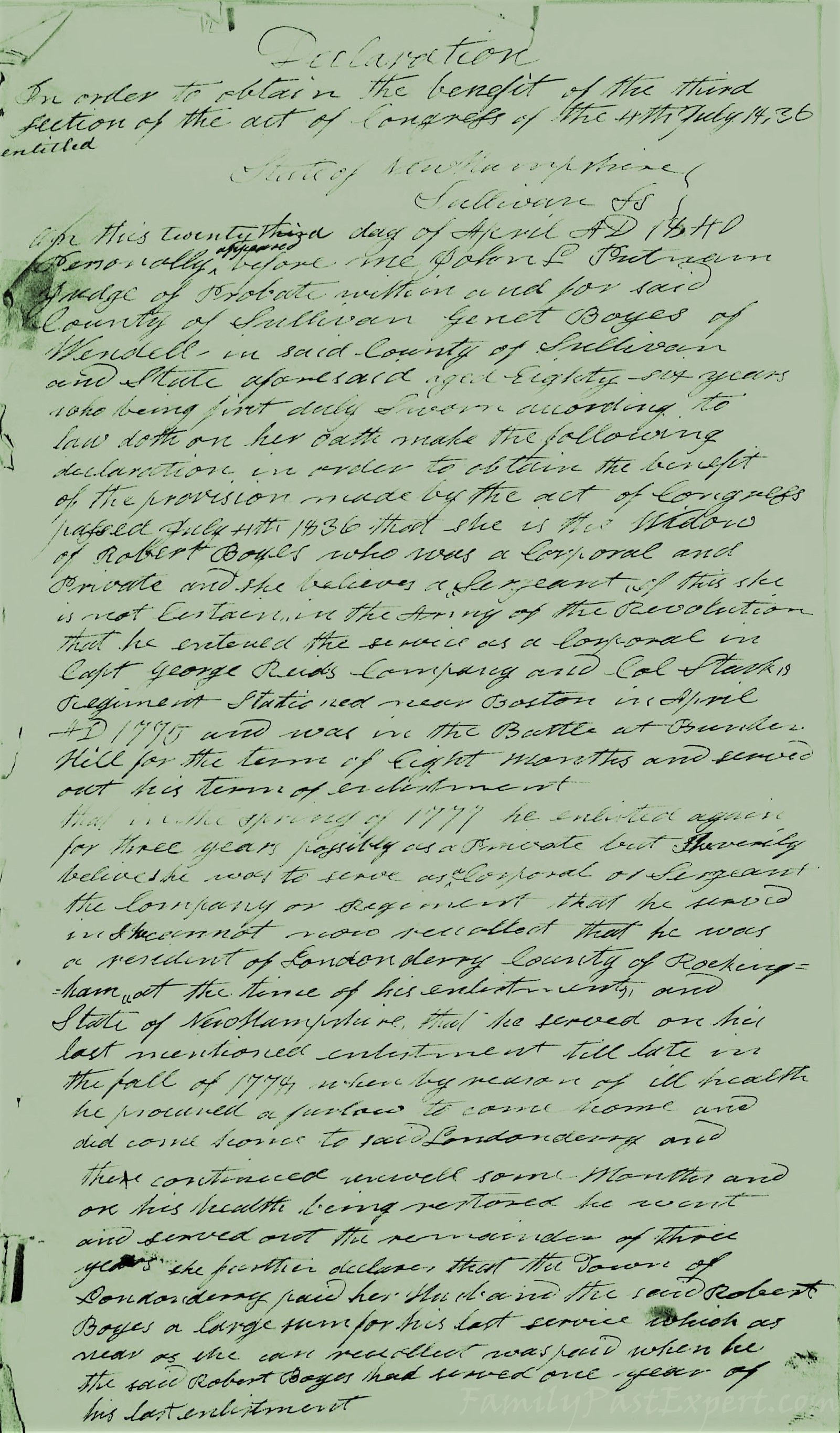
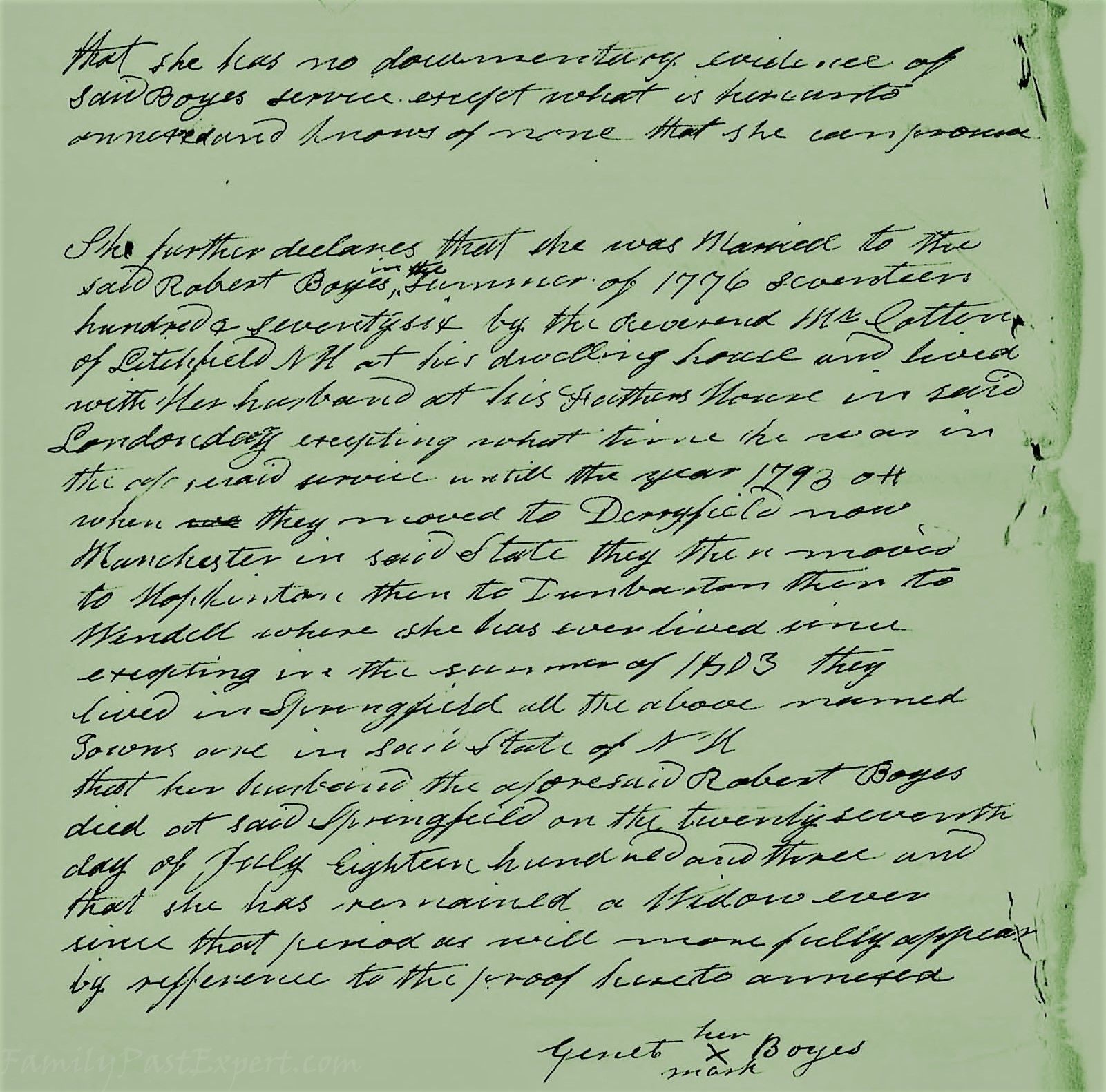
In the pages and pages of pension records, we see that Genet had to prove that she had indeed been married to Robert and she had to prove that Robert had indeed served in the Revolutionary War. Affidavits and testimony was gathered from many neighbors and family members.
Shortly after she began her attempt to get a pension, her sons, Adam and James, tried to halt the pension certificate from being issued because the Selectmen of Wendell had judged 85-year old Genet as a non compos person and incapable of taking care of herself. They wanted to get a guardian assigned for Genet before the pension process continued.
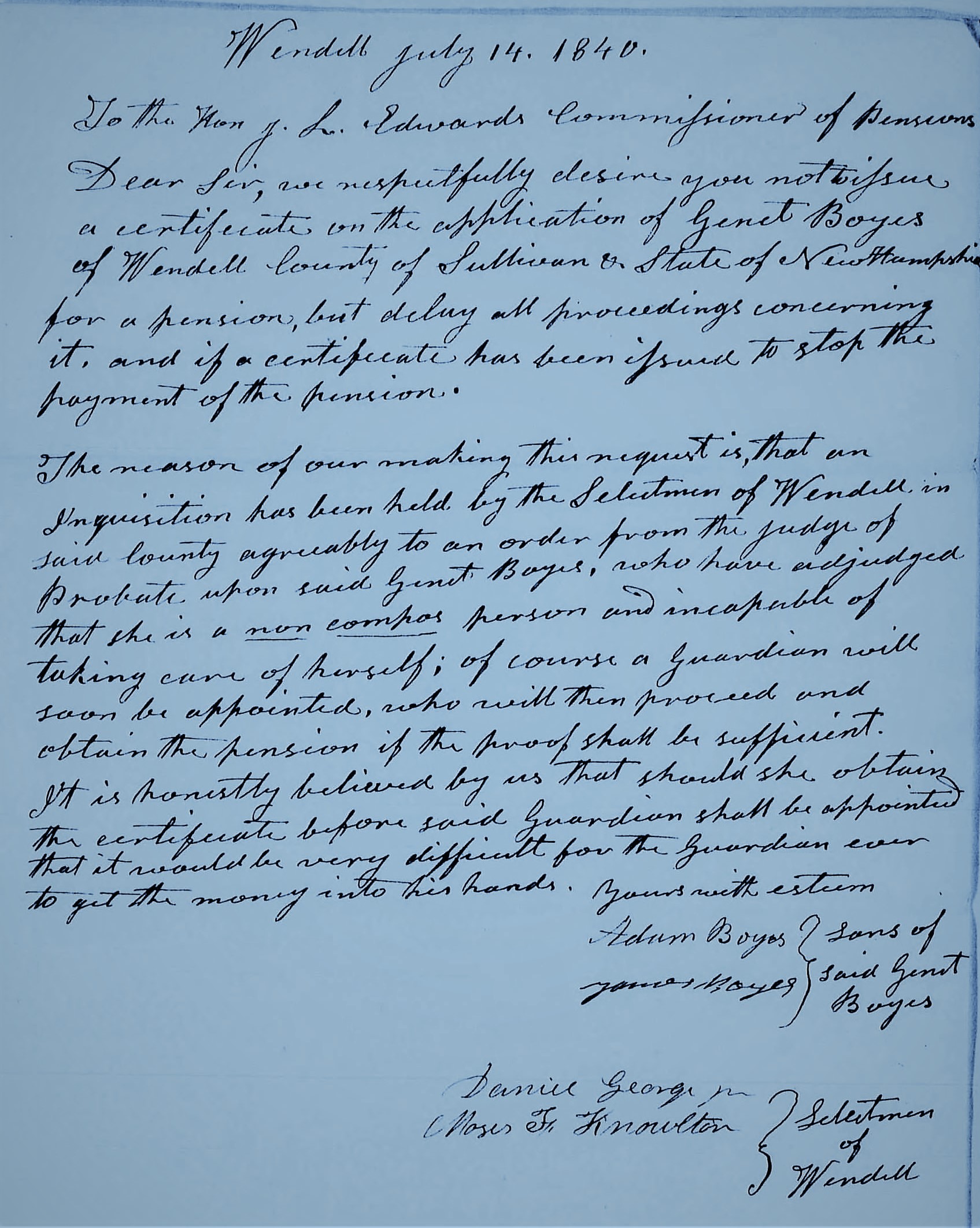
We should note that according to census records, Genet was not living with either Adam or James during the 1840 census. Instead, she seems to have been living with her youngest son, Robert. Before 1850, only the head of household was listed by name in the census, so the 1840 census does not list her by name. But, Robert, who was 41-years old at the time, was recorded living in Wendell, Sullivan, New Hampshire with a woman who was between 60 and 69-years old and another woman who was between 80 and 89-years old. The younger woman was Robert’s 63-year old sister, Mary Boyce Clough who had been widowed about 1819. The older woman was Genet.
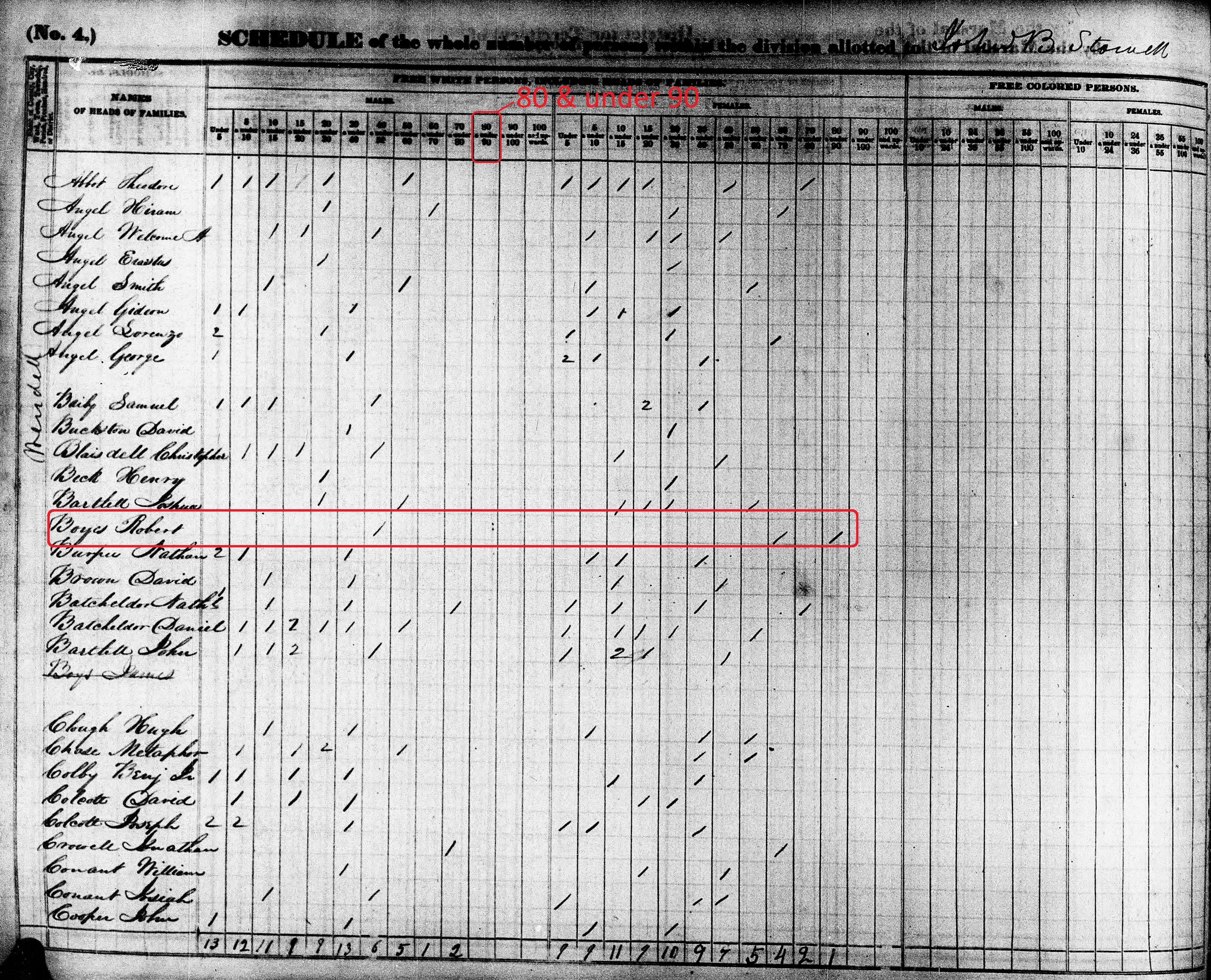
Genet lawyered-up. She appointed a man named Richard Sandborn as her representative for the purpose of securing the pension.
Then, a man named Moses Pillsbury started speaking out against Genet. Moses Pillsbury was the father-in-law of Genet’s son James. Moses claimed that Genet and Robert hadn’t been married when Robert fought at Bunker Hill. Moses went on to testify that Robert had been a deserter during the war.
On 22 Oct 1840, at age 86, Genet applied for half pay and pensions that were guaranteed to certain widows per the 7 Jul 1838 Act of Congress. Finally, she was awarded a pension. The amount was $27.44 per year. (That would be about $786.00 a year now.¹) A month after being awarded the pension, her representative, Richard Sandborn, testified on her behalf, defending her against claims of being incompetent and against claims that Robert had been a deserter.
But, a few months later, Moses Pillsbury was back, again saying that Robert had been a deserter. He continued questioning whether Genet and Robert had ever been married and even went so far as to question Genet’s honesty saying, “she, Genet would testify to any thing that was layd before her.” He also informed the pension administrators that all the money she had received had been spent fighting the guardianship issue. It really makes one wonder what Moses Pillsbury had against Genet.
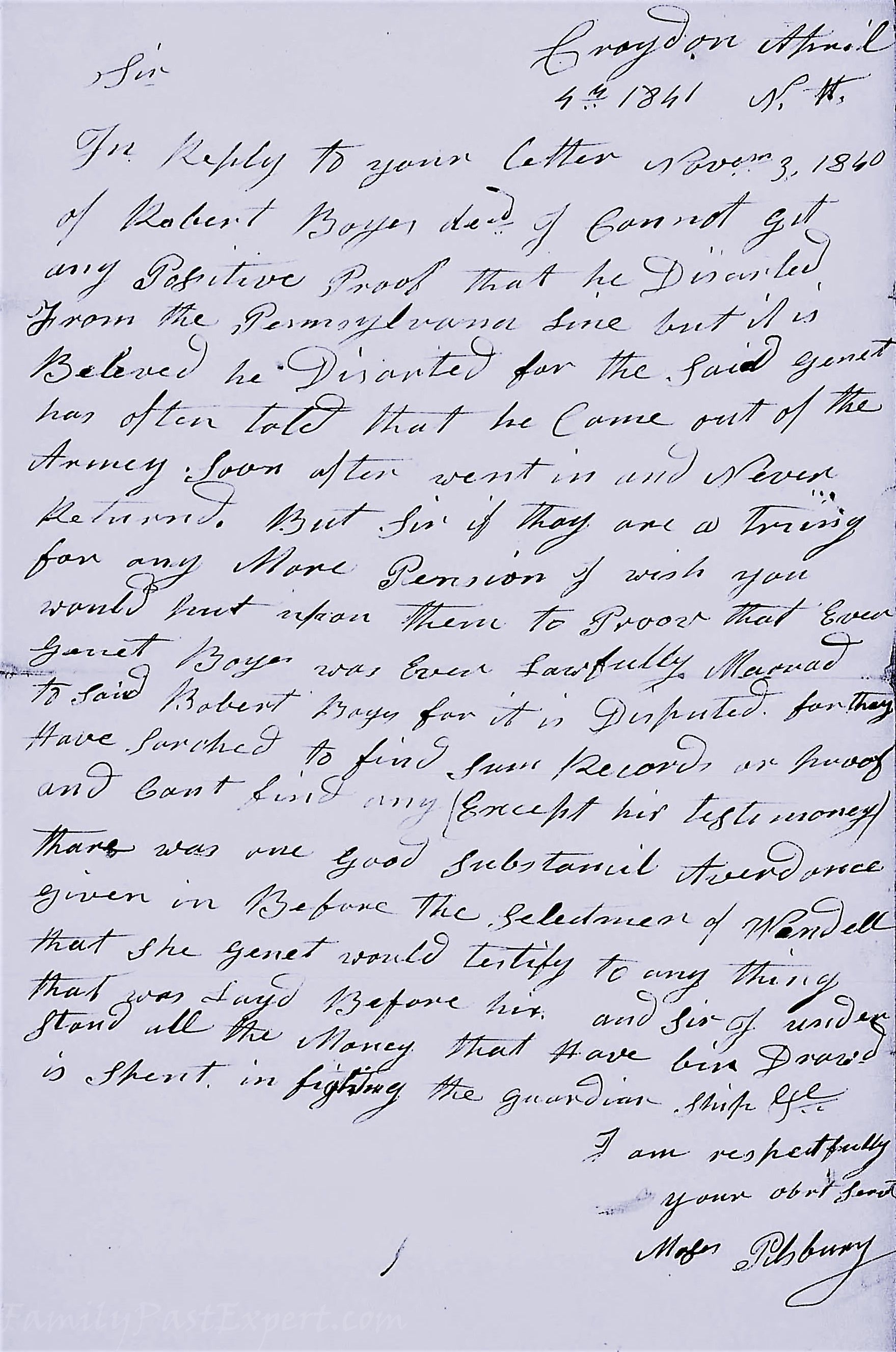
In 1843, Congress passed another pension benefit, and Genet once again applied to get the allowed increased pension. The increase was not immediately granted, so for the remainder of her life, she regularly wrote to inquire about her application status.
Genet Boyes Boyes died, at the age of 91, on 09 Nov 1845 in Wendell, Cheshire, New Hampshire (Wendell was then in Sullivan county).
Her heirs continued the fight for the pension and there continued to be drama for the next decade. In the end, the case was closed. The increase was never awarded.
Probate records indicate that Genet really could have used the increased pension. An inventory of her estate was approved 11 April 1846. She didn’t own a lot of things. Her total estate was worth only $5.74. That would equate to only about $186.00 now.¹ Her most valuable possessions were a steel hatchet and a pewter platter, each worth 75¢. She owned two old bibles, an iron pot, a tea kettle and a loom.
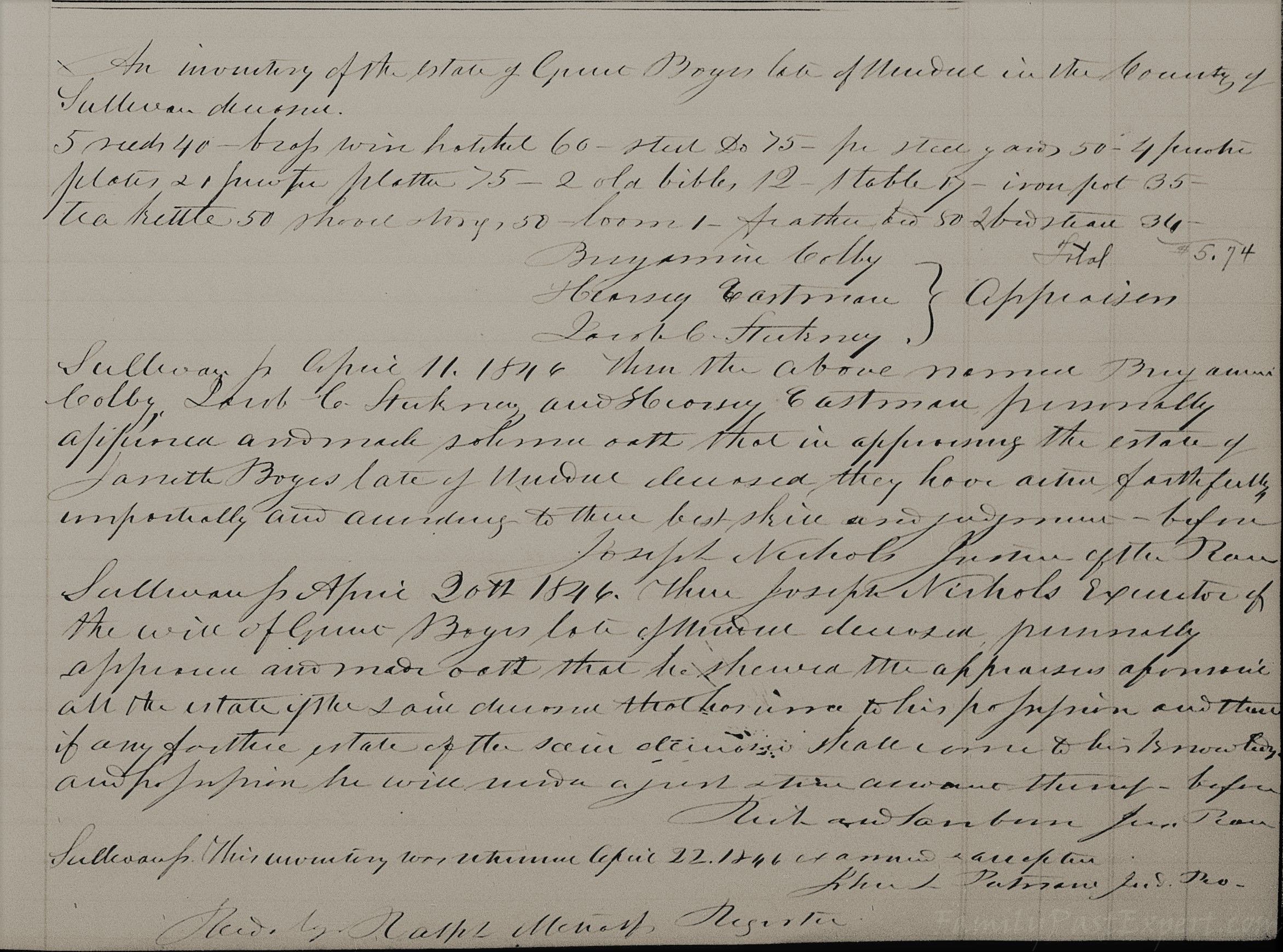
Where is she in the tree?
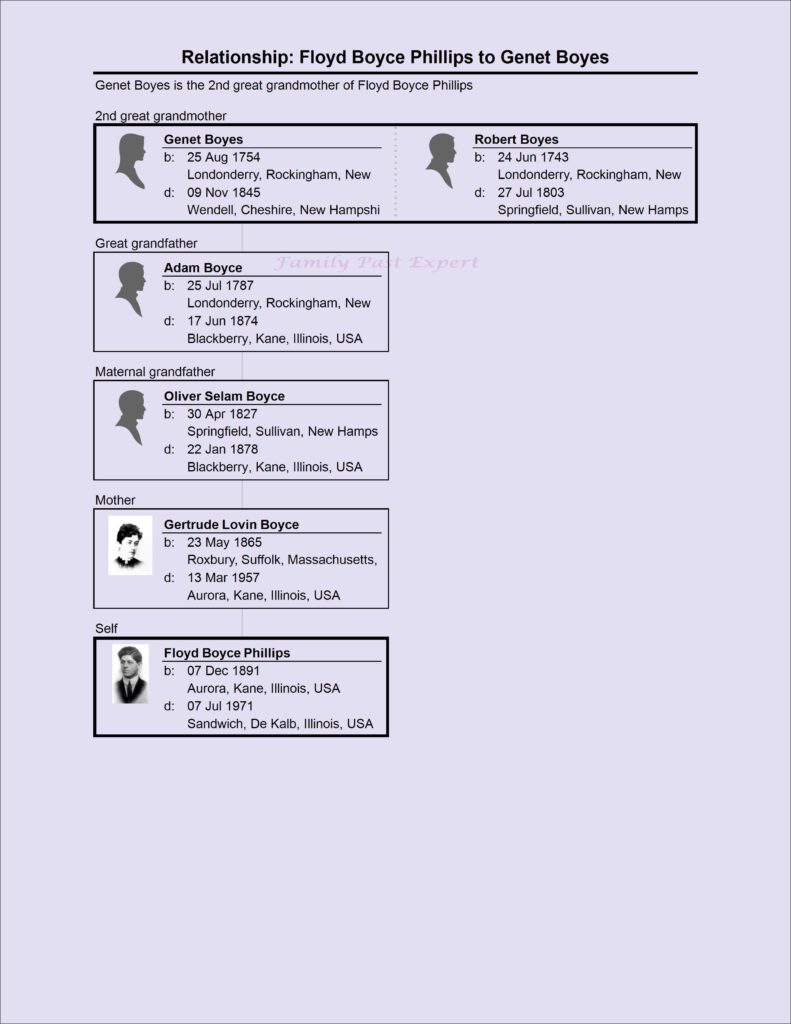
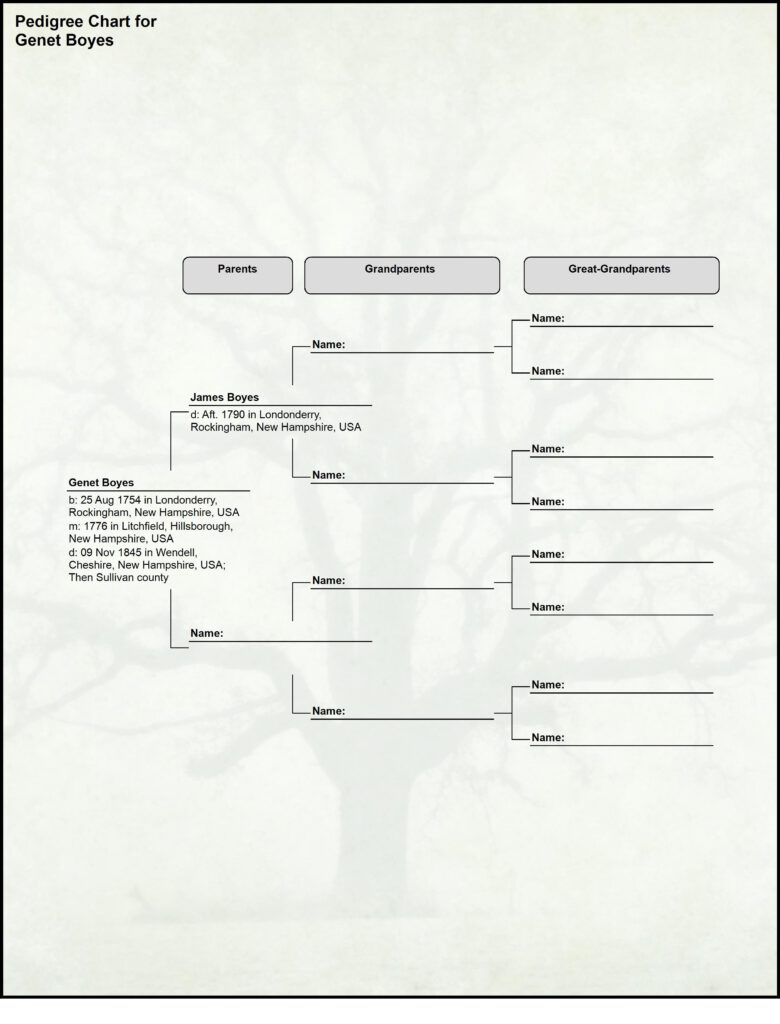
Selected Notes and Sources:
¹There are many ways to calculate wealth. If you compare the value of $27.44 income in 1840 using the historic standard of living, the value of that income in 2016 is $786.00. If you compare the value of $5.74 wealth in 1846 using the historic standard of living, the value of that wealth in 2016 is $186. See MeasuringWorth.com for more calculations.
“New Hampshire, County Probate Records, 1660-1973,” images, FamilySearch (https://familysearch.org/ark:/61903/3:1:3QS7-L9WH-573V?cc=2040537&wc=M79S-W38%3A347814901%2C347838401 : 22 May 2014), Sullivan > Accounts, dowers, inventories 1842-1859 vol 5, 7 and 13 > image 444 of 771; county courthouses, New Hampshire., Family Search – The Church of Jesus Christ of Latter-day Saints, discussion list (familysearch.org).
Revolutionary War Pensions at Fold3, www.fold3.com, Robert Boyce, http://www.fold3.com.
Samuel H. Williamson, “Seven Ways to Compute the Relative Value of a U.S. Dollar Amount, 1774 to present,” MeasuringWorth, 2017.


Leave a Reply